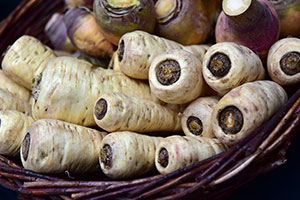 Parsnip Fun Fact
Parsnip Fun Fact
Parsnips that are harvested after a frost will be sweeter than those harvested before a frost. This is due to the stored starches of the plant being broken down and converted to sugar.
About Parsnip
Parsnip is a member of the Apiaceae or Umbelliferae botanical family, more commonly known as the carrot family.
This botanical family consists of many common vegetables and herbs including carrot, celery, parsley, anise, coriander, cumin, dill, and fennel.
Nutrition
Parsnip is a good source of vitamin C, folate, and manganese.
- Vitamin C is an antioxidant, which assists in healthy immune function and wound healing.
- Folate supports protein metabolism, red blood cell formation, and the prevention of birth defects.
- Manganese assists in cartilage and bone formation, and wound healing.
How to purchase, prepare and store
- Parsnips are available year round in your supermarket.
- Choose firm small to medium-sized parsnips. Avoid those that are limp, have soft spots, or are large, as they will have a woody texture and bitter taste.
- Store unwashed parsnips in paper towel and wrap in a plastic bag in the refrigerator for up to two weeks.
- Parsnips along with other root vegetables can last for months in a root cellar.
- You can eat parsnips raw or cooked.
- Parsnips can be baked, boiled, pureed, roasted, grilled, or steamed.
- Add parsnip to your favorite soup, salad, or side dish recipe.
Nutrition Facts
1/2 cup parsnip, cooked, boiled
- Calories: 55.4
- Protein: 1.03 g
- Fat: 0.234 g
- Carbohydrate: 13.3 g
- Fiber: 2.81 g
- Calcium: 28.9 mg
- Iron: 0.452 mg
- Magnesium: 22.6 mg
- Phosphorus: 53.8 mg
- Folate: 45.2 µg
- Vitamin A: 0 µg
Via fdc.nal.usda.gov
Recipes
Request an Appointment